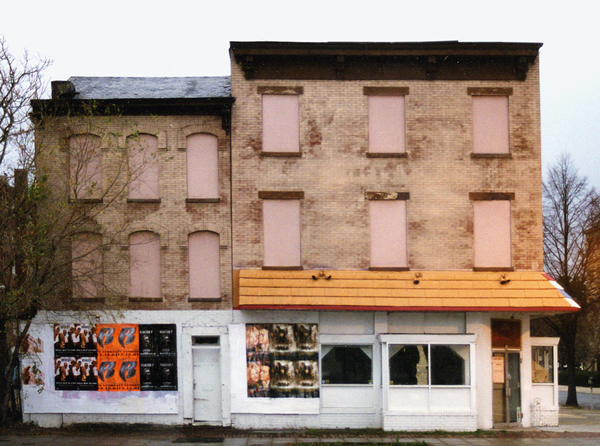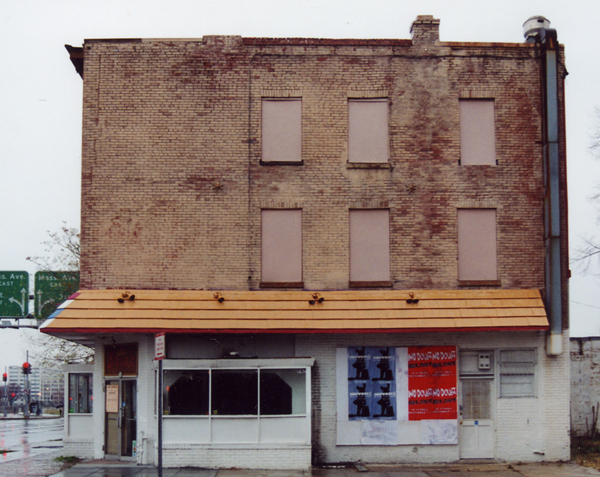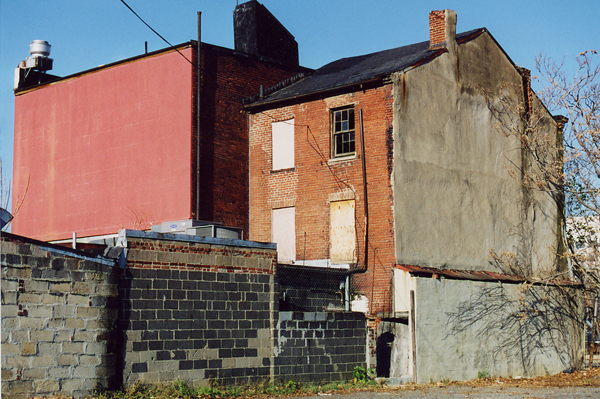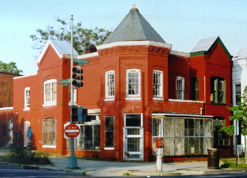
314-316 H Street from Massachusetts Ave NW R
ET nw 
The Vacarros' view as they walked home from their first grocery at 742 4th Street NWR
H 
314 H Street NW shows its gable from the alley
Perhaps you’ve heard about the frustrated commuter who on a whim turned off a clogged highway onto the country lane he’d passed every evening for years. The entrance to the lane was a dark hole fringed with thick boughs that hung almost low enough to scrape a car roof, and within a few minutes, he felt he was miles from the city. After a half hour’s drive through a steady drizzle, he had not passed a house or even a driveway. His disquiet eased when a white oval sign gleamed far ahead in the headlights, but to his disappointment the service station, which was actually a country store with a single pump in front, was closed. Then suddenly he was fighting to pull out of a skidding swerve around the woman who had materialized in the road, or, more exactly, seemed to float just above the pavement on a carpet of mist.
Wordlessly, the woman accepted his offer of a ride and climbed into the front seat. To his disappointment, she was ancient and frail, with frizzled white hair that looked as matted and stained as a used cotton ball. “Live down the road?”, he asked and she nodded. He could not tell if her face was wet with tears or ran, or if she shook slightly from cold or repressed sobs. The possibility of being caught up in a stranger’s travails made him fall silent as the car gathered speed. A minute later he saw a distant tiny light through the streaks on the windshield, and looked at his passenger, who nodded once again. Then he was stopped in front of the gabled silhouette of a house whose only definable feature was a wisteria vine which wound around a peeling gingerbreaded column beside the porch light. Almost at the instant he heard the clunk of the passenger door, he hit the gas, there was a blinding burst of rain, and he found himself at an intersection, where a string of traffic lights gleamed along the wet pavement that led back toward the city.
On the next morning, a Saturday, he awoke early, already mired in guilt and self-contempt. Without pausing for coffee, he retraced the route to work, already framing the words of his apology. The marshy fields along the lane seemed friendly rather than foreboding, and in just a few minutes he was passing the open door of the country store and slowing for the dark house. But where was it? Wheeling the car around, he coasted back, peering into the tangle of cattails and reeds. But there was still no house, as the oval sign loomed ahead.
The store clerk shook his head. “Nobody lives in that swamp. Why don’t you draw what you saw and I’ll try to help.” In a few minutes, the outline of the gable, wisteria vine, and pillar were sketched on the back of receipt.
“Never seen it,” said the clerk, and pointed to the wall behind him. The thumb tacked sketches varied from crude to mere stick figures, but the wisteria-wrapped pillar was visible in each.* * * * * * * * * * * * * * * * * * * * * * * * Perhaps the “vanishing house” is just a pallid permutation of the “phantom hitchhiker” urban legend. But have you ever noticed a new construction site on your way home and had to wonder “what used to be there? When a landmark becomes a phantom, the shock is immediate.”
The current “Victorians of the Week” were passed by thousands of cars morning and evening. But how many passers-by noticed that they had been incorporated in a block-long pit this summer?
314 and 316 H Street NW were among the last survivors of the big German neighborhood that stretched west from Judiciary Square in the late 19th century. The building of 316 H, the large, square 3 story building that stretched around the corner into the 700 block of Fourth Street NW, is lost in the mists of Victorian record-keeping.
314 H was perhaps the two story addition to 316 that one F. Augustfer built in 1887 for use as a dwelling. Or, from the contrasting rear views, it may have been a pre-Civil War building face-lifted to keep in step with its new neighbor.
